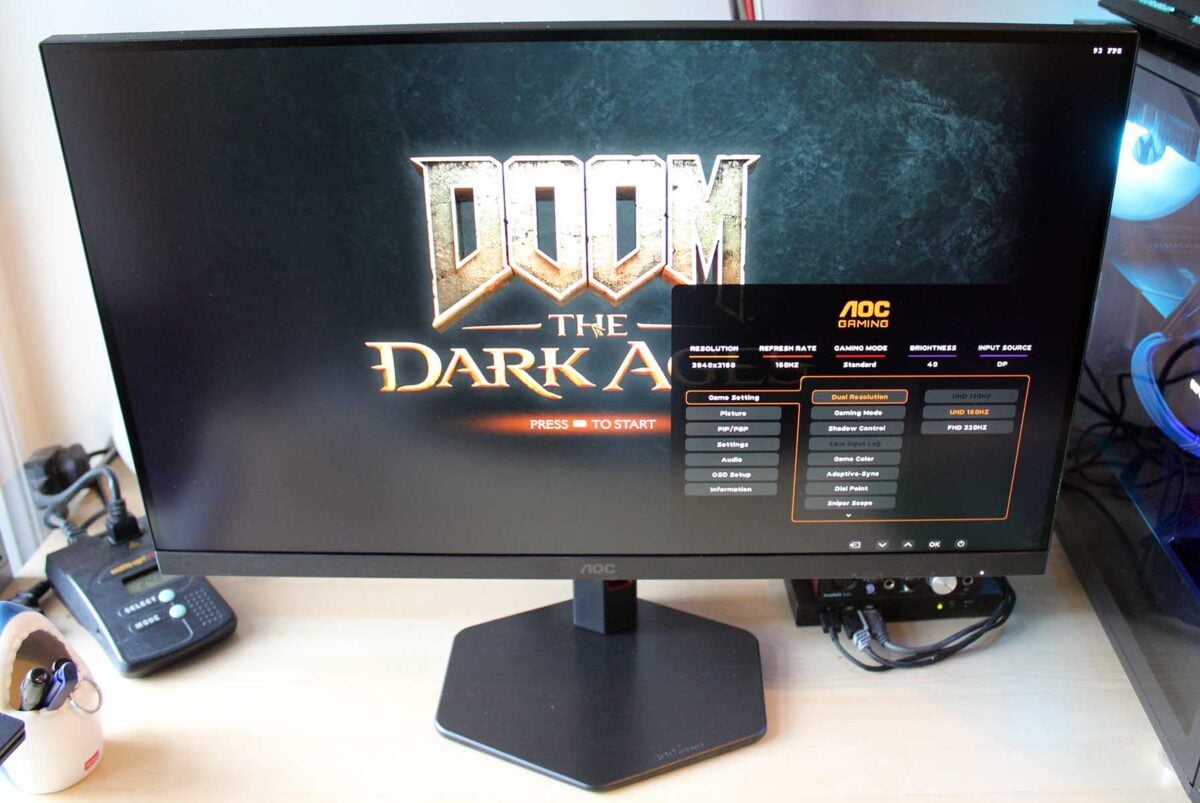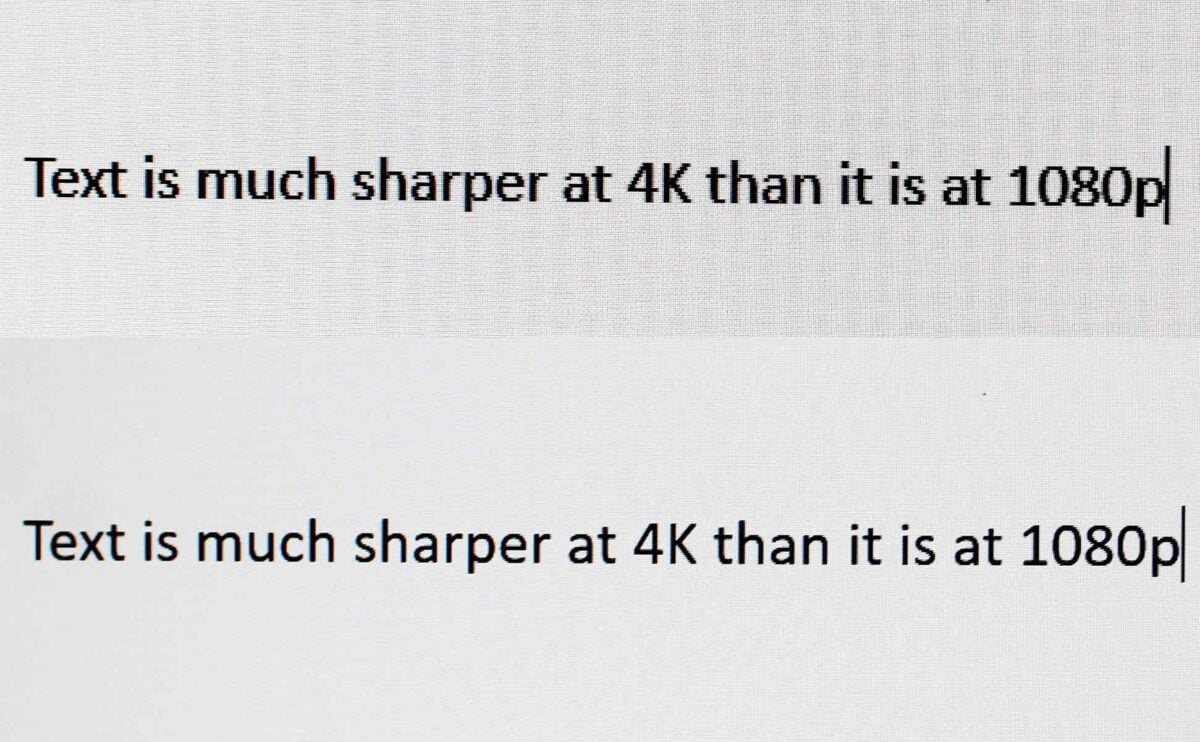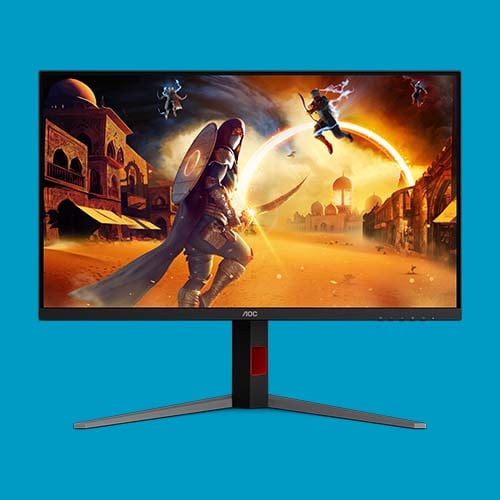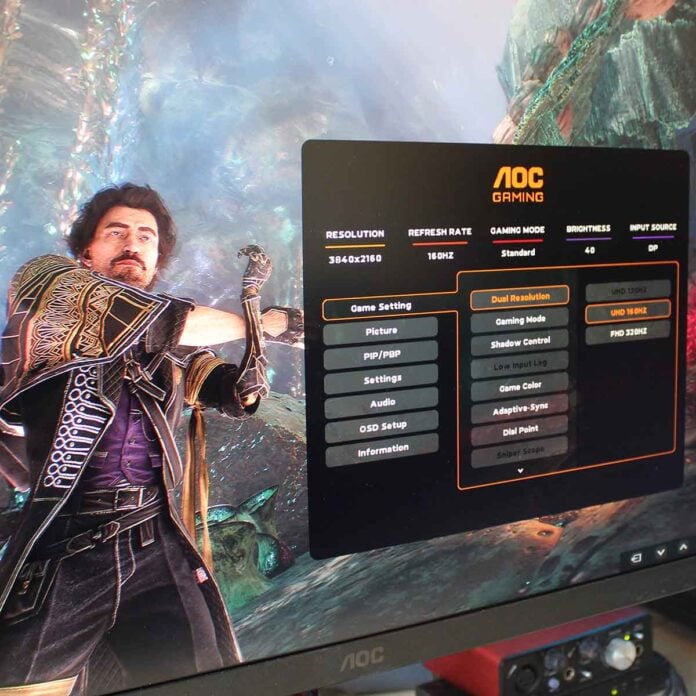Buying a new gaming monitor usually involves a clash of priorities, forcing you to either choose a higher resolution or a faster refresh rate. If you want the sharpest picture possible for work, then you want 4K, but then you’ll need a really powerful GPU to play games at native resolution, and you’ll also sacrifice refresh rate in the process. But there really is a way to have your cake and eat it. Let me introduce you to the new world of dual-mode, sometimes called dual-frame, monitors.
Put simply, a dual-mode monitor lets you have the best of both worlds. I’ve been playing with the AOC Gaming U27G4R for this feature, and it gives you a crisp, sharp Windows desktop running at 4K, along with a decent refresh rate of around 160Hz. Then, if you want to play games at a super-fast refresh rate, you can engage the second mode. This runs the monitor at an effective native resolution of 1080p, but without any of the usual blurriness you get from dropping the resolution.
Importantly, in 1080p mode, you’ll get a much faster refresh rate of 320Hz – double what you’ll get with the 4K mode. That’s not only great for fast-paced competitive FPS games, but it’s also handy if you have one of the latest Nvidia RTX 50 Series graphics cards with multi-frame gen, as your monitor can properly keep up with the smooth motion from the sky-high frame rates.

What is integer scaling?
So how can a 4K screen also run a 1080p resolution natively? The answer is a little trick called integer scaling, and you don’t actually need a dual-mode monitor to run it, although it’s much better if you do have one – more on that later.
Here’s the skinny. Your monitor has a fixed, precise grid of pixels, 3840×2160 in the case of a 4K screen, and this is the native resolution. Dropping the resolution below this point usually results in blurriness, as your screen is no longer operating at its native resolution. It basically has to simulate the downscaling, as unlike an old analogue CRT screen, it can only work with a fixed number of pixels.
Let’s take a 3840×2160 screen as an example, and drop the resolution to 2560×1440, commonly known as QHD. If you divide 3840 by 2560 you get 1.5, rather than a whole number, and the same goes for the vertical resolution. However, you can’t split a pixel in two, so your monitor can only simulate dropping the resolution, using whole pixels and dithering effects to make some of them look like fractions of pixels. The result is obvious blurriness, and that’s why you ideally want to run your games at your screen’s native resolution.

However, if you drop the resolution from 3840×2160 to 1920×1080, you’re dealing with whole numbers (integers) of pixels instead of fractions. A pixel is a square with four sharp edges, which means you can effectively place three more pixels above, below, and to the diagonal of it to create a new quad pixel. This new pixel is just as sharp as the original one, with no blurring, and it enables you to run a sharp resolution of 1920×1080 on a 4K screen – it’s a process called integer scaling.
Usually, your monitor will still simulate scaling when dropping from 4K to 1080p, again resulting in blurriness, but you can force it to use integer scaling instead in your GPU driver. In the Nvidia App, for example, you just need to go to System/Displays, open the Scaling section, and make sure integer scaling is selected. You can then have a sharp 4K screen for work, and drop to native 1080p for gaming, meaning you don’t need a ridiculously powerful GPU to get decent frame rates.
Just bear in mind that dropping to a different resolution, such as 2560×1440, with this setting enabled will result in a black border around the screen. Your monitor is no longer dealing with fractions of pixels, remember, so it has to give you a precise 2560×1440 grid in the middle of your screen instead.

Why would you want a dual-mode screen?
So, if you can already treat your 4K screen as a native 1080p panel for gaming, what’s the point of a dual-mode screen? There are several reasons, but the key one is refresh rate. If you have a 144Hz 4K monitor, using integer scaling to run it at 1080p will mean you’re still stuck at 144Hz, when the latest 1080p gaming monitors are considerably faster. However, with a dual-mode monitor, you’ll also get a much higher refresh rate when you drop the resolution, meaning the best of both worlds.
A faster refresh rate means your monitor can really keep up with displaying fast action smoothly. Your GPU may be able to churn out over 300fps when you’re playing CS2, but that benefit is largely lost if your screen is only running at 160Hz and therefore can’t display all those frames. I’ll add a caveat here, which is that while there is a definite benefit of going from 60Hz to 160Hz and even to 240Hz in most games, it’s harder to spot the difference beyond that point, unless you’re serious about playing fast-paced competitive FPS games. If that’s you, though, then you’ll really want that fast refresh rate.

How dual-mode monitors work
The secret behind this refresh rate boost is very similar to using integer scaling on a standard screen, but applying the same principle of doubling up to both the resolution and refresh rate. Let’s take the AOC Gaming U27G4R as an example. At its heart, it’s a 160Hz 4K screen as standard, with 3,840 lines of pixels going across and 2,160 lines going down, refreshing at 160Hz, or 160 times a second. However, if you engage the second mode, it combines these lines into pairs (both vertically and horizontally), rather than treating them as single lines.
The end effect is to halve the number of pixels both vertically and horizontally, but to also double the refresh rate as it takes half the time to refresh those vertical lines when they’re in pairs. And there, hey presto, you have your 1920×1080 320Hz screen, effectively running at its native resolution. Dual-mode monitors also have two different Extended Display Identification Data (EDID) tables, with which they can communicate their abilities to your PC, whereas most monitors only have one. This means your PC sees the monitor as a genuine 1080p or 4K screen when you switch modes, and adjusts the refresh rate and resolution options accordingly.

AOC Gaming U27G4R
Screen size: 27in
Primary resolution: 3840×2160 / 160Hz
Secondary resolution: 1920×1080 / 320Hz
Price: £229
At 4K, the AOC Gaming U27G4R picture is really sharp, making it great for photo editing, web browsing and content creation. Its incredibly sharp text alone makes having a 4K screen worthwhile for me. It’s also worth pointing out that the U27G4R’s 160Hz refresh rate at 4K is still plenty fast enough for a lot of gaming needs, particularly for single-player titles. The problem is that hitting 160Hz at 4K requires a massive amount of GPU power, and we can’t all afford an Nvidia GeForce RTX 5090. Also, if you like to play fast-paced shooters, where a high frame rate really helps, you want a monitor that can properly keep up with it.
Dropping the resolution down to 1080p on AOC Gaming U27G4R is genuinely like using a fast 1080p screen at its native resolution. Impressively, you can even switch modes while you’re gaming – I tried switching in several games, and watched as the resolution dropped and the refresh rate went up. There’s no blurriness from dodgy scaling, and the refresh rate is super-fast. Action is smooth at 320Hz, and it also fully supports Active Sync in both its modes, including Nvidia G-Sync compatibility. This means it can synchronise its refresh rate with your GPU’s frame rate, so you don’t get any ugly tearing effects.
Dropping to 1080p on AOC Gaming U27G4R is genuinely like using a fast 1080p screen at its native resolution
When you have a huge 4K resolution, dual-mode monitors mean you can also think about going bigger. A 32in screen is great for multi-tasking with work, getting immersed in cinematic single-player games, and watching movies. Plus, if you have a dual-mode 32in monitor, you still get the benefits of being able to run games at a fast refresh rate, while not requiring an overly expensive GPU.
You can even buy 45-inch dual-mode OLED monitors that run at 5120×2160 at 165Hz, enabling you to drop down to a neatly integer-scaled 2560×1440 at 330Hz. They’re not cheap at around £1,799, though, and a much more affordable compromise is a 32in dual-mode IPS screen, such as the AOC Gaming U32G4U. Like the U27G4R, it offers you a choice of two modes. You can run it at 4K with a 160Hz refresh rate, which is ideal for working on the Windows desktop, and running single-player games if you have enough GPU power on tap. However, you also have the option to treat it as a native 1080p monitor with a super-fast 320Hz refresh rate.

There is also a caveat here, which is that while 4K still looks fantastic on a 32in screen for work, games start to look a bit chunky at 1080p on such a large panel, as the pixel density drops to around 69 PPI (pixels per inch), compared with around 82 PPI on a 27in panel. It’s great to have a choice, though. If you have enough GPU power to run your games at 4K, then you have that option, but the U32G4U also enables you to play games at a more easily-accessible resolution, and with a fast refresh rate to boot.
Importantly, you also get convenience. Swapping between the U27G4R’s two modes simply involves pushing a few of the buttons on the front, and selecting the mode you want from the monitor’s on-screen display. Its fast IPS panel also means it’s much more responsive than a VA panel, with very little visible ghosting. It might not be as responsive as an OLED screen, but it’s also less than half the price, currently costing just £229 on Amazon.

AOC Gaming U32G4U
Screen size: 32in
Primary resolution: 3840×2160 / 160Hz
Secondary resolution: 1920×1080 / 320Hz
Price: £459
Speaking of OLED, we’ve seen a few dual-mode screens with this tech already. They’re expensive, but the high contrast and responsiveness of OLED panels are top-notch if you can afford the asking price. AOC has another dual-mode display in the works that will help scratch that HDR itch as well, and you won’t need to worry about the burn-in problems experienced by some OLED screens with this one either.
AOC’s Gaming U27G4XM is due to launch in January 2026, and pairs a fast 27in IPS screen with a mini-LED backlight, giving you 1,152 local dimming zones. AOC says it has full support for the DisplayHDR 1000 standard, with a high maximum brightness level of 1,000cd/m², and a 1,000:1 contrast ratio. It also has the same dual-mode benefits as the U27G4R, with a 320Hz 1080p gaming mode, and a 160Hz 4K mode, as well as Adaptive Sync support with Nvidia G-Sync compatibility.
For my needs, however, I’m completely sold on dual-mode now
A dual-mode screen isn’t for everyone, of course. For a lot of people, a straightforward 2560×1440 screen will cover all your bases, being substantially sharper than 1080p and not requiring the huge GPU power of 4K. For my needs, however, I’m completely sold on dual-mode now. I’ve been a 4K user for over ten years (there’s no going back once you’ve tasted 4K), as I love the sharpness for working in Windows, as well as games when my GPU can keep up.
However, there’s no getting around the fact that playing games at 4K requires a tremendous amount of GPU power, even with tricks like DLSS upscaling and frame gen available to you. A dual-mode monitor genuinely provides the bridge, giving you a sharp 4K screen for work and a fast 1080p screen for play, with no blurry scaling. If you’re thinking about upgrading your monitor, and you want the best of both worlds, a dual-mode screen should be at the top of your short list.


